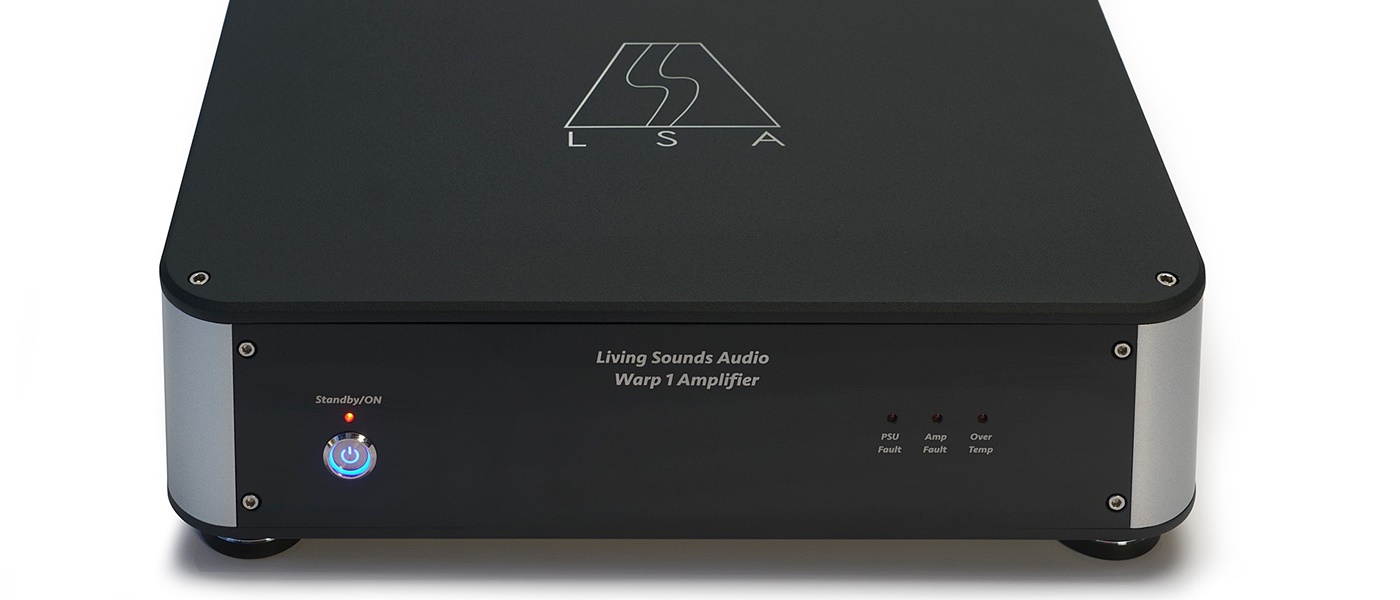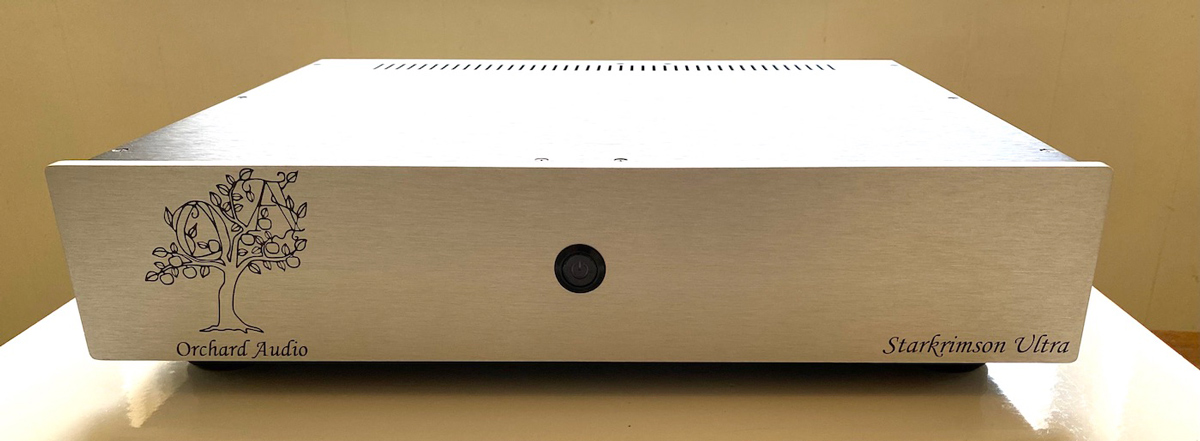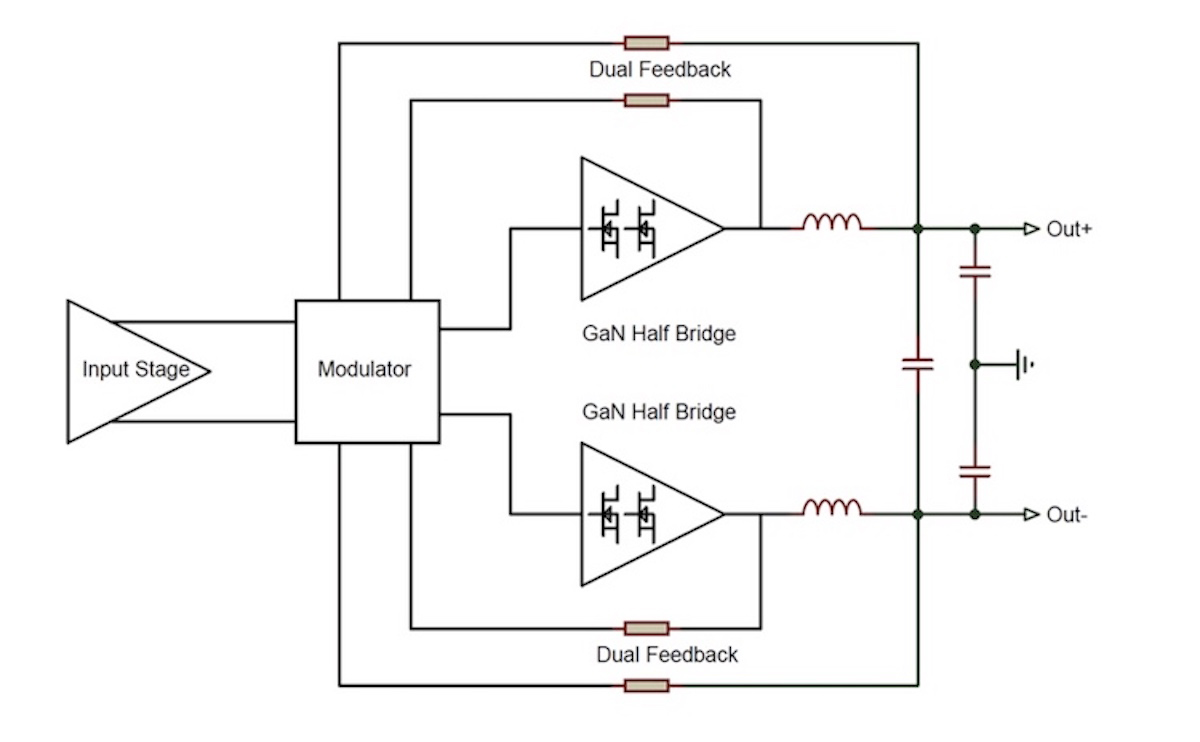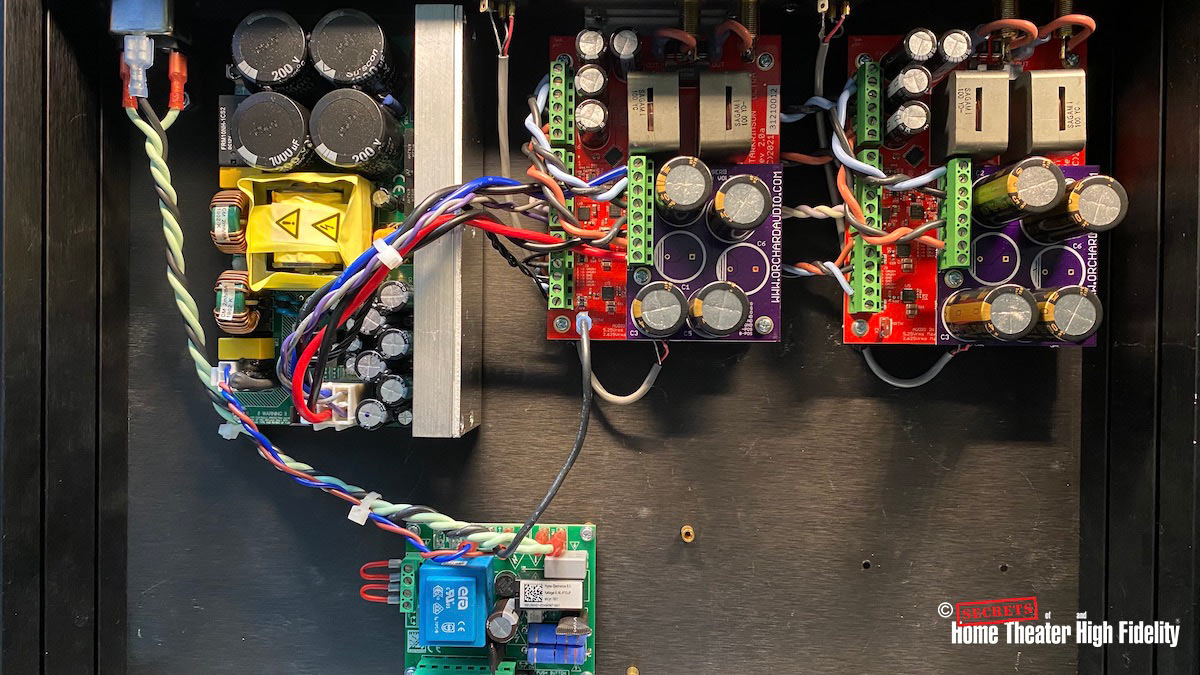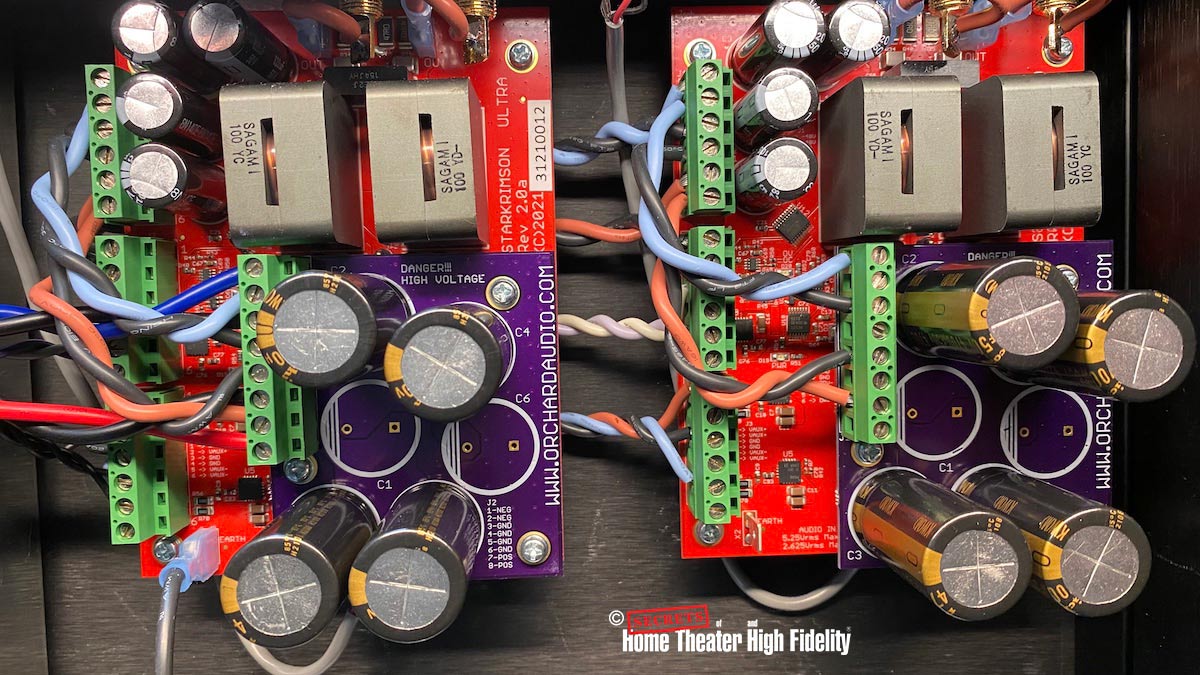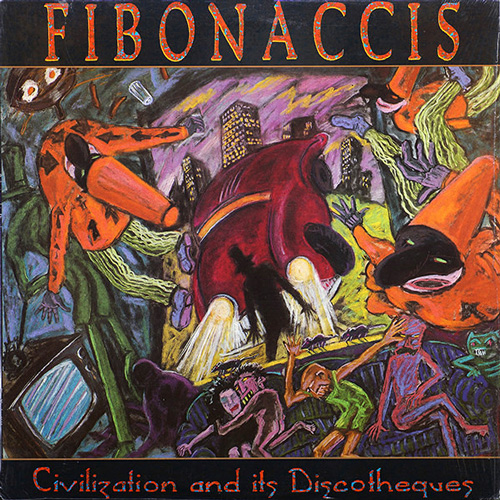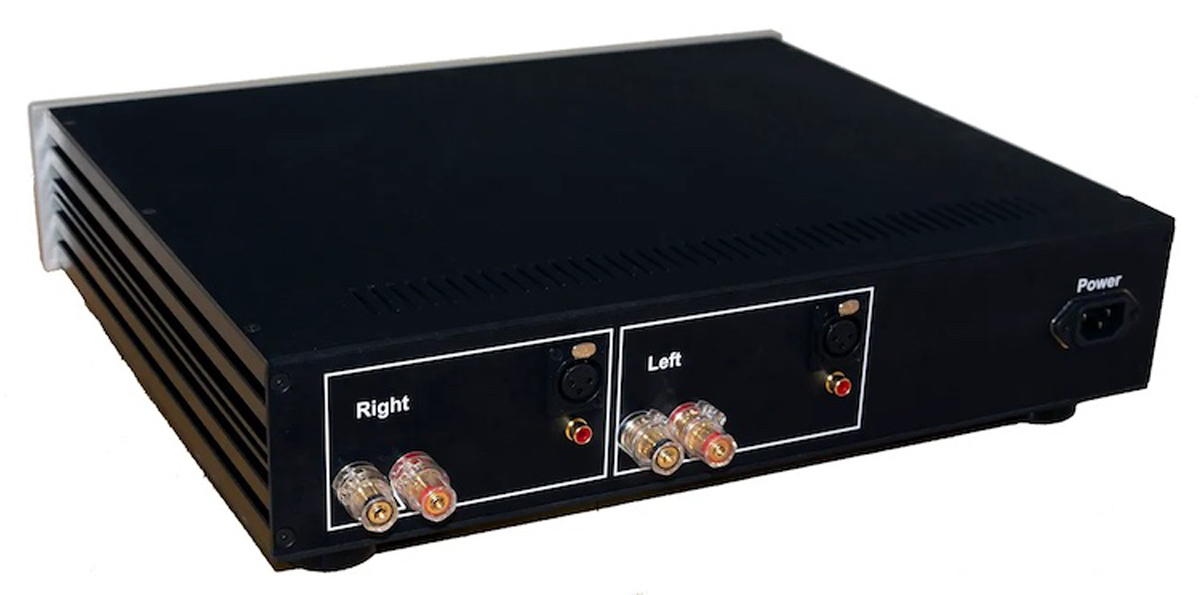Orchard Audio Starkrimson Stereo Ultra Amplifier
- Runs cool
- Weighs very little for its sound output
- Exceptionally transparent sound output quality
- Exceptionally powerful
- Its GaN modules can be upgraded
- Money-back guarantee
- 2-Ohm capable
Leo Ayzenshtat, the founder of Orchard Audio, is someone to watch. He has impressive engineering credentials and he’s using them to shake up the world of audio. New Jersey is where he is designing and building an impressive selection of very forward-thinking components. The Raspberry Pi-based streaming components he is selling, such as the PecanPi, incorporate several features in a streamer that should have been there from the get-go but frequently are not, and he sells them for sensible prices.
But it is his amplifiers that really caught my attention. They are designed around a new kind of transistor that uses gallium nitride (GaN) instead of silicon. Two of the GaN transistor’s benefits over traditional silicon are that they switch much faster and provide for higher efficiency, i.e., they run cooler.
So Ayzenshtat is using GaN transistors to build amplifiers that are, he says, “conceptualized to provide the listener with a truly life-like musical experience, presented with every significant detail intact, in order to convey an emotional connection to the music.”
Full specifications and test results are available at https://orchardaudio.com/
CONFIGURATION:
Fully balanced from input to output two-channel Class D power amplifier based on GaN modules
INPUT VOLTAGES:
110/120VAC
220/240VAC
FRONT PANEL:
Blue LED when the amplifier is powered on
REAR PANEL:
IEC power cord socket
XLR or unbalanced stereo inputs
One pair of five-way binding posts
DIMENSIONS:
45cm (17.72″) x 36cm (14.17″) x 11cm (4.33″) excluding binding posts
WEIGHT (NET?):
6.5kg (14.33 pounds)
SIGNAL-TO-NOISE AND DISTORTION RATIO
5W 1kHz:
102.5dB into 16Ω
5W 1kHz:
100dB into 8Ω
5W 1kHz:
97dB into 4Ω
GAIN:
19.05dB (Balanced)
25.05dB (Unbalanced)
SIGNAL-TO-NOISE RATIO:
120dB (A-weighted, 22kHz BW)
RESIDUAL NOISE:
44.72uV (A-weighted, 22kHz BW)
FREQUENCY RESPONSE:
DC – 80kHz+
SENSITIVITY:
5Vin for 250W into 8Ω (Balanced)
5Vin for 500W into 4Ω (Balanced)
2.5Vin for 250W into 8Ω (Unbalanced)
2.5Vin for 500W into 4Ω (Unbalanced)
INPUT IMPEDANCE:
44kΩ (Balanced)
22kΩ (Unbalanced)
GaN MODULE OUTPUT POWER:
4Ω:
500Wrms (1000Wpeak)
8Ω:
250Wrms (500Wpeak)
16Ω:
125Wrms (250Wpeak)
DAMPING FACTOR:
<700 @ 1kHz
GaN MODULE TOTAL HARMONIC DISTORTION:
@ 10W:
<0.0004% (-108dB) for 1kHz into 8Ω
@ 0.25W:
<0.0016% for 20Hz – 20kHz into 8Ω
@ 10W:
<0.0006% for 20Hz – 20kHz into 8Ω
@ 62.5W:
<0.001% for 20Hz – 20kHz into 8Ω
@ 250W:
<0.016% for 20Hz – 20kHz into 8Ω
@ 10W:
<0.0005% (-106dB) for 1kHz into 4Ω
@ 0.25W:
<0.0021% for 20Hz – 20kHz into 4Ω
@ 10W:
<0.0007% for 20Hz – 20kHz into 4Ω
@ 125W:
<0.0018% for 20Hz – 20kHz into 4Ω
@ 500W:
<0.08% for 20Hz – 20kHz into 4Ω
MSRP:
$2,499.95 USD base price. $2,899USD as tested with 37,600uF rail capacitance option. Add $550USD for dual mono configuration (two power supplies). Add $1000USD for dual mono configuration with 28,200uF rail capacitance per channel.
Website:
Company:
SECRETS Tags:
Orchard, audio, amplifier, Starkrimson, class D, GaN, module, gallium, nitride, amplifier reviews 2022
Orchard Audio owner Leo Ayzenshtat had adapted Leonardo da Vinci’s credo, “Simplicity is the ultimate sophistication.” To that end, he has designed and built a deceptively simple audio amplifier that adheres to that credo. Two GaN modules, one or two Hypex power supplies, and one or two circuit boards for capacitor upgrades are all that you will find inside the chassis of the Starkrimson Stereo Ultra. But what you will not find is a toroidal power transformer or massive heat sinks. It is those components that bring most of the weight to typical high-power amplifiers.
The Starkrimson Stereo Ultra is a Class D design. The “D” in Class D does not mean digital, by the way. This is an analog switching audio power amplifier. Pulse-width modulation (PWM) is performed completely in the analog domain and is then amplified by the GaN power stages.
How it differs from typical solid-state amps is that it employs GaN transistors instead of the silicon transistors that have been used for decades. GaN-based semiconductors were created in the 1980s. Other applications of GaN include military electronics such as radar transmitters and charging devices for phones and tablets. GaN is also required for blue-light-emitting diodes, which are used in the laser pickups found in Blu-ray video players. So, it’s possible you’ve been using GaN in your entertainment system without knowing it.
However, the engineering advantages of GaN transistors also present engineering challenges. You can’t just pop a GaN transistor in place of a silicon transistor in a circuit. You have to design an entirely new circuit to accommodate the greater capabilities of the GaN transistor. However, because GaN transistors are so efficient, you don’t need the hardware required for dissipating heat, such as heat sinks. And less heat means less stress on wiring and components in an enclosed box, and, more importantly, less thermal noise.
Starkrimson amplifiers use Ayzenshtat’s proprietary DC-coupled, fully balanced dual feedback modulator. This allows the amplifier to be completely balanced from input to output, through the use of bridged GaN power stages. GaN technology enables the Starkrimson Ultra’s transistors to switch at roughly 800kHz, which is two to three times faster than traditional Class D amplifiers which use silicon transistors. This very fast switching allows for the use of a simple LC (inductor and capacitor) filter, which allows the amplifier to have practically no phase shift from DC (0Hz) to 30kHz. This filter is a very important part of a Class D amplifier. The Starkrimson Ultra also uses oversized very high-quality, oxygen-free copper (OFC) inductors and a very high-grade film capacitor.
Secrets Sponsor
Having high-quality components will only get you so far; the Starkrimson Ultra’s four-layer PCB is state-of-the-art. It uses a custom stack-up with high-end dielectric (insulating) material and ENIG (gold) finish. The amplifier also utilizes one or two Hypex power supplies, a soft-start module, and can be configured for 110/120V or 220/240V power.
The Starkrimson Stereo Ultra can be purchased pre-assembled in three configurations. Its base price is $2,499.95USD. For $400USD more you get a 37,600uF capacitor upgrade. For $550USD more you get a dual-mono amplifier, which uses one Hypex power supply per GaN module. And for the ultimate Starkrimson Stereo Ultra, add $1000USD and you get the dual mono configuration with a 56,400uF increase in power capacitance.
The online order process will let you choose an AC line voltage and power cord for one of several countries. And for inputs, you can choose either RCA or XLR inputs, but not both. And you can choose a silver or black faceplate, with the Orchard Audio logo silkscreened on its left and the words “Starkrimson Ultra” in an italic typeface on the lower right. And for an extra $300 Ayzenshtat can put a custom color on the faceplate.
Ayzenshtat provides a one-year warranty, and you can return it within fourteen days for a full refund. He assembles the components himself in New Jersey. His work is clean, with neat, well-dressed cabling, good soldering joints, and no loose parts. Oh, and the name “Starkrimson”? That’s a variety of pear. And a type of pear was chosen because you also need a “pear” of modules in each amp. Ayzenshtat has named all of his products after things that grow in orchards, hence the name of his company: Orchard Audio.
Yes, you can build one yourself. Ayzenshtat sells the GaN modules and other components of his components separately, so you can build a custom amplifier to fit your particular needs and budget. Need a five-channel Starkrimson Stereo Ultra for your home theater? Build it yourself! Want an assembled Starkrimson Stereo Ultra but can’t quite afford it? You can buy the modules à la cart and assemble it yourself. He is active on several audio and DIY websites, has an active YouTube channel, and is quick to answer any questions you may have about his products. Ayzenshtat even has a video series on YouTube demonstrating how to build his amps and streamers. I’ve watched them, and I believe you need only basic soldering skills to assemble one of his amps.
For an amplifier that makes so much power, the Starkrimson Stereo Ultra only weighs a little over fourteen pounds, and that makes it easy to move it around. The unit I had was configured with balanced XLR inputs and the 37,600uF capacitor upgrade. It was not the top-of-the-line dual-mono configuration, which means there was only one Hypex power supply for both GaN modules.
Just recently, I was so impressed with the Meier Audio Corda Soul DAC that I bought one of his DACCORD-FF DACs, but that DAC does not have balanced outputs. My Schiit Freya + preamp does, however, so I ran the DACCORD-FF into the Freya+ and the Freya+ balanced output into the Starkrimson Stereo Ultra. An Oppo UDP-205 and Xbox Series X were my digital sources. For my first listening sessions, I used the Polk Audio L600 speakers, then moved to the Spatial Audio M4 Triode Masters. Finally, I used the stock power cord that Ayzenshtat sent with the amp and plugged it into my 20A home circuit outlet; I did not plug it into my P.I. audio UberBuss power conditioner.
The amp comes with a printed warning about its power input. You must not power it on until all of the connections are properly made. That means power cord, analog inputs, and speaker outputs. And you must wait five minutes after powering it off before removing any of the connections. Otherwise, the setup was quick and straightforward.
To power on the amp, you click the power button on the front, and a blue LED lets you know the amp is powered on. I heard absolutely nothing through my speakers after powering it up. No clicks, thumps, noise, hiss, or power rush. This thing is dead silent.
I’ve been very fortunate lately on my HiFi journey. First, the Polk Audio L600 speakers showed me how important bass really is to playback and how much of it I had been missing. Then the Meier Audio Corda Soul DAC showed me what transparency can do to audio playback. And then the Starkrimson Stereo Ultra amplifier showed me just how transparent my entire system could be.
Compared to the Krell S550i integrated amp I use daily, the Starkrimson Stereo Ultra showed a much faster and finer resolution of the upper frequencies of the human voice, and a far greater ability to play more of the microdetails of a recording. When played through the Krell, vocals had a raspiness and distance that didn’t exist with the Starkrimson Stereo Ultra. The Krell’s lower end was wooly and not nearly as well defined in the soundstage as it was with the Starkrimson Stereo Ultra; the bass imaging was more clearly etched in space. The Starkrimson Stereo Ultra made the Krell sound positively slow like the music was dragging a few seconds in the past. When I switched out the Krell for the Starkrimson Stereo Ultra, I immediately missed the clarity and detail of the Starkrimson Stereo Ultra.
Secrets Sponsor
Over the years, I’ve realized that if a speaker can handle a lot of power, then you should give it a lot of power. When I first had the Polk Audio Legend L600 speakers, I experimented with single and bi-amping with relatively low-powered amps in the 30W to 50W zone. And the speakers produced enjoyable music, which is hard not to do when using vintage Mcintosh power. But I didn’t begin to understand what the L600s were capable of until I powered them with the 500W Krell. I got more of all the frequencies and energies of music when the speakers had that much power, especially with bass output. The Krell weighs sixty pounds, is built like a tank, and can drive the L600s without breaking a sweat. But what the Starkrimson Stereo Ultra showed me about the Krell is that a lot of power does not always produce the amount of speed and microdetails the speakers are truly capable of. I think one of the major factors here is the speed of the transistors used in the Starkrimson Stereo Ultra.
With the Starkrimson Stereo Ultra powering the Polk Audio L600 speakers I heard pinpoint bass imaging. With older jazz recordings, my system has never been very good at showing me just where the bassist is. With the perennial “Kind of Blue” on Red Book CD, the bass fiddle had always been a blurry mass of low frequencies somewhere in the back of the soundstage. With the Starkrimson Stereo Ultra, for the first time, I could actually see where Paul Chambers was. Low-level detail and spatial cues for the bass and all other instruments were easy to visualize in the soundstage. The music simply happened and I could lose myself in its ebb and flow. And with smaller jazz ensemble recordings, like one of the four-man Sonny Rollins sessions, the musician’s position on the soundstage was pinpoint accurate. Again, the speakers just disappeared and the music just happened.
Another great surprise was how much more I heard out of my Spatial Audio M4 Triode Master open-baffle speakers with the Starkrimson Stereo Ultra. These speakers were always capable of disappearing, whether they were powered with a 30W tube amp or a 500W solid-state amp, but the Starkrimson Stereo Ultra gave them a speed and transparency I’d never heard from them. So much more of the mid-to lower-range of music I hadn’t heard out of those speakers became readily apparent, and, once again, bass imaging improved in ways I didn’t think possible with this speaker. I have found these speakers to be particularly easy to drive; I once used a 2.5W amp on them to great effect, even with their 93db efficiency rating. But feeding them up to 500W with the Starkrimson Stereo Ultra gave me the best sound out of them I’ve ever heard. Of particular note was the improvement in vocals. I heard depths of human emotion and intent with the Starkrimson Stereo Ultra that I hadn’t heard before. That’s the kind of low-level detail this amplifier is capable of expressing.
The sound of the amplifier with both pairs of speakers was balanced overall and non-fatiguing. I heard no smearing between the ranges of frequencies, which is a quality of my vintage Klipsch Cornwalls I could never solve. With the two different pairs of speakers, I heard an organic coherence of sound presentation across the entire frequency range with the Starkrimson Stereo Ultra’s power and speed.
I listened to a wide variety of music for hours on end and never felt fatigued. I could hear no particular overemphasis or absence of any range of frequencies. It seemed like everything that should be playing was playing. That’s not to say the Starkrimson Stereo Ultra will improve a poor recording. Depending on your sources, the Starkrimson Stereo Ultra will play exactly what you feed it, good or bad. And if you’re source components are slow, the Starkrimson Stereo Ultra will not speed them up. Be warned; the Starkrimson Stereo Ultra may lead to further system upgrades. My digital playback components are of higher quality than my analog playback components, so listening to vinyl with the Starkrimson Stereo Ultra was enjoyable, but it made me want a more expensive and transparent phono preamplifier.
Robert Wyatt, Shleep (Domino DNO207, 2008)
On this album, Robert Wyatt frequently echoes his vocals note-for-note with instrumental backup, and often with more than one instrument at a time. It adds depth and clarity to his vocals, and I had no idea how important that was to Wyatt’s music until I listened to it with the Starkrimson Stereo Ultra. It is a subtle, but important aspect of his music that I had never heard before. The Spatial Audio M4 Triode Masters excel with the human voice, and when powered by the Starkrimson Stereo Ultra the human intent of Wyatt’s music became more apparent, which made the listening experience all the more satisfying.
Wyatt has a very earnest yet still somehow vulnerable singing voice, and the Starkrimson Stereo Ultra enabled me to experience more of the emotional impact of Wyatt’s music.
The Fibonaccis, Civilization and Its Discotheques (16-bit/44kHz FLACs from Bandcamp played via Oppo UDP-205)
It is indeed a very good time to be a fan of music from the 1980s. The amount of previously unreleased music making it to the digital streaming services continues to grow daily. The Fibonaccis released a single album and an EP in the 1980s, and a retrospective CD compilation in 1992, and that’s been it. But recently the band reissued its original vinyl releases digitally to Bandcamp and streaming services, and also released not one, but two compilations of previously unreleased tracks.
The Fibonaccis made music equally informed by the west coast New Wave of the time and soundtrack music from the likes of Bernard Hermann and Ennio Morricone. I think of them as a mix of Wall of Voodoo and Slapp Happy. I’ve listened to this album on vinyl for over thirty years, but hearing it through remastered FLACS through the Starkrimson Stereo Ultra and Polk Audio L600 speakers gave me much more of the full impact and humor of their music.
I could understand how percussionist Joe Berardi’s careful use of Rototoms, splash cymbals, and bells not only integrated with the feel and flow of the music but also added depth. I also heard the depth of his floor toms’ thump and long decay. Keyboardist John Dentino layered several tracks of a wide variety of keyboards, from contemporary synthesizers to a mellotron, and I could hear each one distinctly. It was a delight to hear so much more musical detail in an album I’ve listened to for so long. The Starkrimson Stereo Ultra did that for me with pretty much everything it played.
Vanessa Wagner, Study of the Invisible (24-bit/96kHz streamed via Qobuz and Roon via Oppo UDP-205)
Wagner is a French pianist who not only plays Britten and Mozart, but she also interprets contemporary music from the likes of Harold Budd, Suzanne Ciani, and Ryuichi Sakamoto. Study of the Invisible is a double album of Wagner interpreting eighteen pieces, and it is an absolute wonder of piano playing. Her piano’s timbres are warm and substantial, her playing thoughtful, and her interpretations very thought-provoking.
Also notable is the quality of the recording. The recording space around the piano sounds immense, and the Starkrimson Stereo Ultra enabled me to hear pedal movement and note microdetails to extents I never thought possible with the Spatial Audio M4 Triode Masters. And the quality and duration of the decay of notes as they echoed and merged and decayed into the recording space was mesmerizing. This is easily one of the best piano performances I have ever heard, and the Starkrimson Stereo Ultra showed me just how much nuance and emotional impact are available in the recording.
At a price of $2899 as configured, the STARKRIMSON STEREO ULTRA is the most expensive amplifier I’ve ever reviewed. It is also the most transparent amplifier I’ve ever had in my system.
- Very transparent sound quality
- Very lightweight and easy to move around
- Never runs warm
- GaN modules can be upgraded
- Available in several configurations
- Can be bought and assembled yourself
- Produces an effortless and immense amount of power
- Orchard Audio proprietor Leo Ayzenshtat is easy to communicate with
- Both balanced and unbalanced inputs
It enabled me to connect with music in a way I did not know my system was capable of. I cannot imagine there is a pair of speakers this amplifier could not sound good with, especially considering it can handle a 2-Ohm load. This amp is not exactly cheap, but I believe it provides a level of speed and transparency that would cost much more. Leo Ayzenshtat has achieved something remarkable with his GaN module-based design, and I’m sure he is capable of bringing more new innovative audio components to the market. In fact, I enjoyed the Starkrimson Stereo Ultra so much that I bought the review unit. Recommended.


